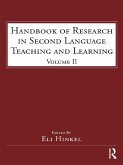12 themes:
- Trends and Recent Issues in Teaching and Learning Arabic
- Social, Political and Educational Contexts of Arabic Language Teaching and Learning
- Identifying Core Issues in Practice
- Language Variation, Communicative Competence and Using Frames in Arabic Language Teaching and Learning
- Arabic Programs: Goals, Design and Curriculum
- Teaching and Learning Approaches: Content-Based Instruction and Curriculum
- Arabic Teaching and Learning: Classroom Language Materials and Language Corpora
- Assessment, Testing and Evaluation
- Methodology of Teaching Arabic: Skills and Components
- Teacher Education and Professional Development
- Technology-Mediated Teaching and Learning
- Future Directions
The field faces new challenges since the publication of Volume I, including increasing and diverse demands, motives and needs for learning Arabic across various contexts of use; a need for accountability and academic research given the growing recognition of the complexity and diverse contexts of teaching Arabic; and an increasing shortage of and need for quality of instruction. Volume II addresses these challenges. It is designed to generate a dialogue-continued from Volume I-among professionals in the field leading to improved practice, and to facilitate interactions, not only among individuals but also among educational institutions within a single country and across different countries.
Dieser Download kann aus rechtlichen Gründen nur mit Rechnungsadresse in A, B, BG, CY, CZ, D, DK, EW, E, FIN, F, GR, HR, H, IRL, I, LT, L, LR, M, NL, PL, P, R, S, SLO, SK ausgeliefert werden.









